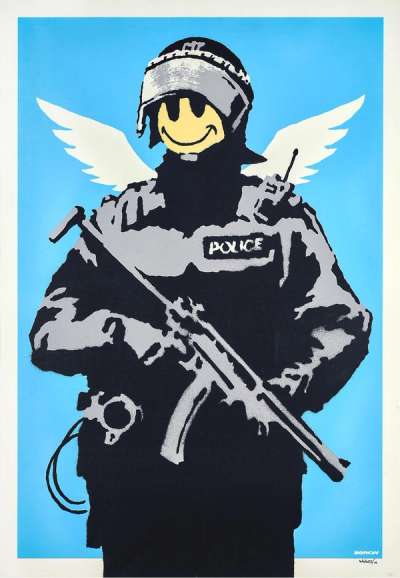Banksy's Sorry The Lifestyle You Ordered Is Currently Out Of Stock

 Sorry The Lifestyle You Ordered Is Currently Out Of Stock © Banksy 2013
Sorry The Lifestyle You Ordered Is Currently Out Of Stock © Banksy 2013
Banksy
266 works
Few pieces capture the zeitgeist of contemporary art as succinctly as Banksy's 2013 mixed media work, Sorry The Lifestyle You Ordered Is Currently Out Of Stock. Here, the subversive artist delivers a sharp commentary on consumer culture, set against the backdrop of Damien Hirst’s renowned spot paintings. By superimposing his message over Hirst's methodically arranged dots, Banksy disrupts the rhythm, creating a powerful visual protest against the mass-produced uniformity that defines much of our modern existence. This artwork acts as a cultural mirror, reflecting the commodified nature of contemporary art and life.
Sorry The Lifestyle You Ordered Is Currently Out Of Stock: Meaning and Analysis
Sorry The Lifestyle You Ordered Is Currently Out Of Stock first appeared in a large-scale stencilled work on the side of an empty building in London's East End in 2011. The piece presents a bold juxtaposition: Banksy's stark spray-painted words cut through the clinical perfection of Hirst's spots, challenging the viewer to question the authenticity of their desires in a world where lifestyles are packaged and sold out as quickly as the latest trends. The splatters and streaks that accompany Banksy's stencilled text offer a striking contrast to the meticulously placed spots beneath. Where Hirst's work speaks to a cold precision, Banksy introduces a human element, a chaos that cannot be manufactured or replicated. It is this human touch, this acknowledgment of imperfection, that underlines the core message of the artwork.
Beyond its aesthetic impact, Sorry The Lifestyle You Ordered Is Currently Out Of Stock is a reminder of the illusory nature of consumer fulfilment, even within the art world. It suggests that the lifestyles we are sold are as out of reach as they are out of stock, mere illusions in the marketplace of desire. It is a piece that questions the originality and soul of mass production while calling on the viewer to seek out the authentic in themselves and the world around them. Its place at the intersection of art and consumerism illustrates Banksy’s dialogue with Hirst in a loud, public debate on the walls of our cities. This work is a testament to how street art has the ability to transform any space into a forum for discussing societal issues, and even critique those that are the top of their game in the art market.
The conversation Banksy sparks with this piece extends beyond the boundaries of traditional art criticism. It seeps into the everyday, confronting the public with the realities of their consumerist engagements. Banksy, notorious for his evocative use of public space, ensures that his message is not confined to the galleries and the elite but is accessible to the passersby, to those who live within the culture he critiques. Banksy's works’ own meteoric rise in value mirrors the increased public interest in street art and its capacity for commentary. In this case, a work criticising the commodification of culture becomes a commodity itself, highly sought after by collectors and art enthusiasts alike. The market continues to grapple with the dichotomy presented by Banksy's art, and how to reconcile the artist's anti-establishment ethos with the establishment's eagerness to own a piece of that rebellion.
“By placing chaotic, stencilled text over methodical spots, Banksy challenges viewers to question the authenticity of manufactured desires and the illusion of consumer fulfilment.”

Banksy vs. Hirst: The Intersection of Art and Consumerism
The relationship between Banksy and Hirst in the context of Sorry The Lifestyle You Ordered Is Currently Out Of Stock is one of both homage and biting criticism. Banksy’s piece enters into a visual and conceptual dialogue with Hirst’s work, specifically his infamous spot paintings, which are emblematic of Hirst's exploration of mechanical reproduction and pharmaceutical aesthetics. Banksy’s choice to superimpose his own message over the precise, machine-like dots of Hirst’s paintings suggests a playful yet pointed jab at the commodification and serial production that Hirst's work is often interpreted as critiquing yet embodying. It is as if Banksy is using Hirst’s own language to articulate a dissenting view about fame and notoriety in the art world. In this sense, Banksy both acknowledges the importance of Hirst's work in contemporary art and also usurps it to make a broader statement about consumer culture.
There is a sense of irony in Banksy's engagement with Hirst. While Hirst’s works, which are often seen as commenting on society, are in turn critiqued by Banksy for being part of that very market, Banksy himself has become a high-value commodity within the same system. Thus, the relationship is one of intertwined critiques, where both artists are seen to be questioning the nature of art in a market-driven context, albeit from different angles. Banksy’s work can be viewed as a conversation with Hirst rather than a one-sided critique. It acknowledges that Hirst's spot paintings have become a part of our visual language, a cultural touchstone that he can riff off to communicate his own message. By engaging with Hirst’s work, Banksy places himself within a continuum of contemporary artists who are deeply enmeshed in the paradox of criticising the commercial system while being part of it.











